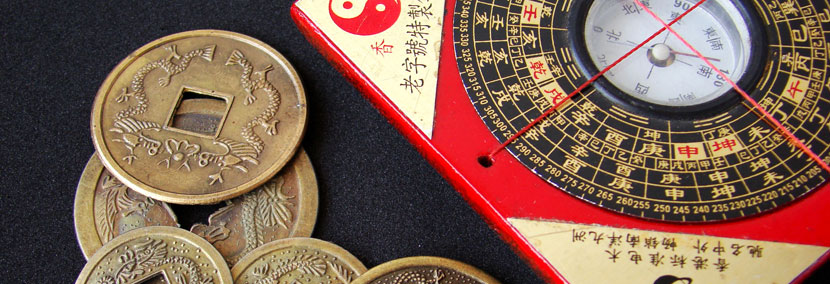
I have used my edition of the I Ching (and the Tarot combined with psychic insight) for doing readings for over 20 years. The I Ching is in text form and uses almost the same universal symbols as the Tarot does in picture form. It is consulted in regard to a current problem. Via a method of random divination using coins or stones, one allows the subconscious to choose the section of the book that mostly closely corresponds to your question. It is amazingly accurate, especially when reviewed later. Partners have been known to receive the same texts, even when in different countries.
The symbolic images of the I Ching relate specifically to patterns within nature; hence they can be incorporated into a landscaped area, a small garden, a courtyard – even a corner. The natural Taoist philosophy on which this is based, is also the basis of Feng Shui. The word Tao means travelling lightly on your path. While Feng Shui means Wind and Water – two of the Eight Trigrams that are the main symbols of the I Ching and which are also shown on Feng Shui charts or mirrors. (Trigram is a three line diagram.)
Feng Shui is sometimes overlaid with superstition and exaggerated claims. But it simply suggests creating a space for each part of your life within your environment and consciously choosing the best sites, patterns, shapes, etc. Zen Buddhist and Taoist land scapers learn how to create such harmony and wholeness, both within themselves and in their houses or gardens, as a visual manifestation of balance and beauty.
Each Chinese or Zen Garden (in Japan or elsewhere) needs to be in sympathy with its environment, e.g. by using many native plants, or going with the flow of the land, or orienting a dwelling in the best direction. In Australia this means having the living or outdoor areas face the North or North East, with shelter from both West (for the heat) and the South (cold winds).
Zen landscaping and the Taoist principles of Feng Shui can now be seen on almost every gardening show on Australian television (whether they know it or not). The overall aim is balance between nature and architecture – brightness and shade – cultivation and wildness – warmth and coolness – the material and spiritual. Water is the most important symbol in Taoism, as the ocean is a symbol for the Great Tao, or the Ultimate Reality. A watercourse represents the flow of life, or flowing with the Tao, or humility – as water seeks the lowest level.
In Japanese Zen monasteries, white gravel is raked to look like waves on a sea-shore, as we are one with the Ocean of Life. Miniature mountains, gorges, lakes, waterfalls and streams are often included. They can suggest swift flowing streams in mountains, the main image for I Ching Hexagram No. 39. Each section in the I Ching is called a Hexagram (a six line diagram made up of two trigrams).
Here are ideas to include Feng Shui and I Ching Symbols in your house and garden
- A place for Tai Chi exercise. Water dragons if you have a pool with rocks. (The Trigram of Heaven is associated with high energy and the dragon.)
- Rocks that look like mountains, animals or people. A Phoenix motif. (Hexagram No. 2 stands for the stability of rock, as well as the Phoenix – endings and renewal.)
- Wind chimes, a gong, a Tibetan singing bowl, relaxing music, or a bamboo flute. (Hexagram No. 16 – Enthusiasm – sound and music.)
- A Golden Robinia tree, rather than Willows that break water pipes (this alludes to the Trigram of Wood/Wind.)
- A small fountain among miniature mountains (as in No. 4 – The Beginner – the start of a river.)
- Raked gravel like a sea-shore. (Waves are like lifetimes in the Ocean of Life.)
- A miniature bridge with small wise figures, signifying any transition made with wisdom.
- Balance between light/shade, wild/cultured, busy and peaceful (as in the black and white Yin/Yang symbol.)
- A fire-place. An outdoor cooking/eating area.(No. 13 Fellowship/Friendship.)
- A miniature mountain made of small rocks. (Trigram of Mountain – structure.)
- Trees or shrubs with Autumn leaves, reflected in water. (Trigram of Lake – The Joyous.)
- Rockery with small shrubs and flowering plants (as in No. 46 – new growth.)
- Floodlit wall, tree or structure (No. 22 – Elegance.) Paths with lights. (Light/shade.)
- Clumping or sacred bamboo, always best in pots. Spring bulbs along a path.
- Stepping-stones. (Trigram of Thunder – The Unexpected, Spring, the Foot.)
- An essential oil burner. Incense. A stone spirit-house, for the nature spirits.
- Vegetable and herb pots or patches. Fruit or nut trees. (No. 27 – Nourishment.)
- Sheltered warm spots. Sunflowers, best in pots. (Trigram of Fire – The Fiery/ sunny.)
- Stone/pottery/metal tortoise, best near bamboo. (The tortoise is the I Ching itself.)
- Large tub of water with goldfish. [Trigram of Water – feelings, or a cooling element.)
- Pottery, a mural, statues of Buddha, Kwan Yin or religious figures. (No. 50 – Art.)
- Surprises, twists and turns, unexpected corners, as life is always surprising. (No. 51 – The Awakening or Unexpected.)
- Meditation seat, an alcove, a pavilion, an altar. (No. 52 – Stillness.)
- Bird feeders rather than cages, bird baths, nesting boxes. Safe places for pets/animals. Frogs and ledges for them to hide. (No. 62 – Protecting the Small or New.)
- Several round objects [as there are no straight lines in nature]. A Pi Disk (round with square hole in centre) which symbolises Creation.
- A Ying/Yang symbol. An Eight Trigram Feng Shui mirror. (Both represent wholeness.)
- Mirrors to reflect outside views or gardens, or to enlarge small rooms. Used well in shops, dining rooms, or on narrow halls. This can transform restricted areas.
- Lastly, for decorating use the colours of sage green (for growth) and gold (for wealth).
I am sure you can use some of these Feng Shui ideas and I hope they bring you joy.
Quotes from Part II – The Tarot and the I Ching of “The Handbook to the Holistic I Ching” and “The Holistic I Ching” by Judith. Copyright © 1993.











